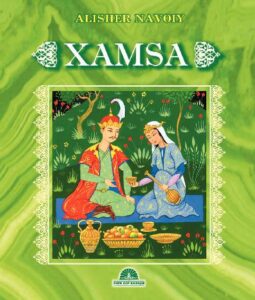SHARE WITH FRIENDS:
Hamsa
The culmination of Alisher Navoi's work was the work "Khamsa" (1483-85), the poet was one of the first to create a complete "Khamsa" in Turkish and proved that it is possible to write such a large-scale work in Turkish.
"Khamsa" includes such epics as "Hayratul-abror", "Farhod and Shirin", "Layli and Majnun", "Sab'ai Sayyar", "Saddi Iskandariy".
Hayratul-abror reflects the poet's philosophical, socio-political, economic, scientific, enlightenment, moral and aesthetic attitude to the Creator, being, nature and man after the chapters of praise, supplication, speech and wonder. It means the indistinguishability of the king and the nation from a human point of view, and the king's inability to transcend the nation in the way of profession, morality, justice, fairness, logic, and piety.
In Farhod and Shirin, the protagonists define the role of man in history and the future through love adventures, teaching that humanity is not only in love, but also through the protection of that glorious name. He artistically reworked the events of Khusrav and Shirin in the history of the East, and through Farhod expressed his views on the perfect man. Through the Navoi epic, the traditions of Firdavsi, Nizami, and Dehlavi were renewed, and then this plot played a key role in solving the core problems of Turkish classical literature.
In the epic Layli and Majnun, a well-known plot found its way through Arabic fairy tales, in which the philosophy of love was expressed in a unique way. It became the spiritual basis for the later epics of Fuzuli, Andalib, and Sayqali. In Hamsa's Sab'ai Sayyar and Saddi Iskandariy, he brought the kingdom to the forefront. These epics are distinguished by their socio-political character and originality in the tradition of Hamsanavism. Hamsa was highly praised by the teacher Abdurahman Jami (1414-1492).
The Manuscripts Fund of the Academy of Sciences of the Republic of Uzbekistan contains 15 manuscripts copied in the 20th and 166th centuries. In 84 of them all the epics of the five are given.
Foreign scientists A.Vamberi, J.Malokolin, F.Richard, L.Vari, Y.Ekman, E.Partele about "Khamsa"; Russian researchers I. Krachkovsky, V. Bartold, E. Bertels, Konrad, B. Zhirmunsky, A. Yakubovsky, A. Semyonov; Turkish scholars F. Koprulu, ASLevend, K. Eraslon; Azerbaijani scientists H. Arasli, G. Aliev; The works of Uzbek scientists Fitrat, I.Sultan, V.Zohidov, A.Kayumov, T.Jalolov, S.Nazrullaeva, A.Abdugafurov, M.Hakimov, S.Hasanov and others are known.
B.Kasimov, B.Akrom, H.Boltaboev, A.Erkinov, D.Farmonova are conducting research on the study of "Khamsa" at the National University of Uzbekistan.
